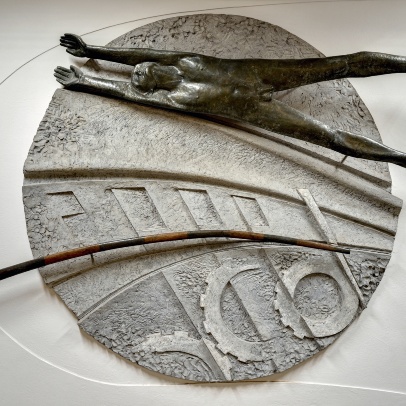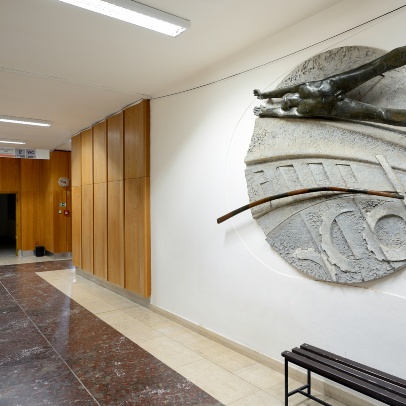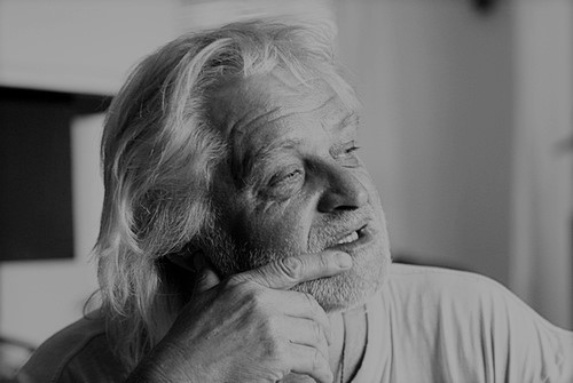Name: In the Beginning Was the Wheel / Scientific-Technical Revolution
Author: Pavel Drda
Dating: 1987–1990
Location: Interior of the Central Library of VŠB-TUO, Ostrava-Poruba
Execution: A circular relief made of laminate, with relief elements of tinned copper plate with dimensions approx. 200 x 260 cm
FLYING OR JUMPING OVER?
In 1990, a remarkable work of art was installed in the corridor on the first floor of the new building of the University library. Its author is the Wallachian sculptor Pavel Drda (*1958), who has mostly preferred to work with clay in his art. His studies at the Ceramic School of Applied Arts in Bechyně, which preceded the years he spent at the Academy of Arts, Architecture and Design in Prague in the studio of Josef Malejovský, predestined him for this ancient material of artistic expression. In the material aspect, however, the relief for the University represents an exception as it is made of laminate (a circular relief creating the background) and tinned copper sheet (a figurative relief element). Because of this, Drda even invited the co-author, Martin Ceplecha, to cooperate. Judged by the resulting effect, the choice of this material combination was successful.
The 1987 project assignment was entitled The Scientific-Technical Revolution. However, the given topic that suited the mission of a technical university library sounded too official to the sculptor. Fortunately, it was also broad enough, so he could modify its content to suit his own nature. At that time, Drda often listened to Voskovec and Werich (also as V + W), and he knew their song Civilization, which viewed the topic of human progress somewhat critically during the economic crisis of the 1930s. In the beginning, there was the amazing invention of the wheel (symbolized by three cogwheels at the bottom part of the relief), but its inventor wanted too much for it from the people, so another round thing that offset its cost emerged – money. Although the song was actually a criticism of the pre-war world “order”, it is questionable whether such source of inspiration that was, in fact, sceptical of progress would have been approved by the artistic committee in the late 1980s. But finally, Flying, as the statue is called spontaneously, was realized.
However, is it really a flying figure that we could boldly assign to a crowd of popular astronauts travelling the universe in the state of weightlessness? In that case, the astronaut would be missing an important attribute – a spacesuit! Our “Flying” is clearly naked. He represents more of an athlete (an Olympian with all the attributes), who is jumping over the bar, which is present in the relief on the one hand as a bent copper rod, and also in a figurative sense, as a 2000 figure inscribed on the track (depicted) in the back design. Drda thought of the approaching turn of the century and the millennium, which promised a symbolic step forward. The fact that this jump over the imaginary time bar finally did not meet all of society’s expectations basically demonstrates that the lyrics of the song by the duo V + W are still topical. So looking at Pavel Drda’s relief, we can ponder how far forward the wheel has actually moved us…


